#Oracle DBMS Mailing Lists
Explore tagged Tumblr posts
Text
Oracle DBMS Customers List
Oracle DBMS Customers List
Buy Prepackaged & Customized Oracle Database Users List, Oracle Applications Decision Makers lists and Oracle DBMS Users list By SIC Code That Let You Reach Targeted Markets In The USA, UK, Canada, Europe & Australia!
Global Reuters Oracle DBMS user lists span the globe, with regionally categorized databases.
Oracle DBMS Leads At Your Fingertips!
At, Global Reuters, we put you in touch with thousands of multi-million dollar companies that constitute the global Oracle user community. We have a proud history in the field of application marketing and our oracle database users list are guaranteed to set your sales targets on fire! All our records are permission-based and are sourced from strictly authentic sources that include business conferences, publications and other secure information portals.
Unlike the vast majority of list vendors, Global Reuters provides you with entirely exclusive contacts that come with a 98% delivery guarantee. We can help you break into multiple niche markets that use a host of Oracle DBMS applications, including,
Oracle Databases Users List
Oracle Real Application Clusters Users List
Oracle Data Warehousing Users ListOracle Database Security Users List
Oracle Exadata Database Machine Users ListOracle Database Users List
Oracle Embedded Applications Users ListOracle MySQL Users List
Oracle Corporation, as a premier provider of database management systems, luxuriates in a multi-billion dollar annual turnover. An offering of over 5000 business software products ensures that the Oracle line fuels a substantial market in application development. However, breaking into that market, requires an extensive client sourcing program and drains away resources that could be more profitably utilized.
All Oracle DBMS Mailing Lists provide complete marketing information including;
First NameLast Name
Company NameJob Title
Mailing AddressPhone Number
Fax NumberMailing Address
Company WebsiteIndustry
SIC CodeNAICS Code
Employee SizeRevenue Size
LinkedIn ProfileAnd More.!
Maximize on your DBMS application sales. Contact Global Reuters now.
Call us today at: 1-800-265-6655
Email us at: [email protected]
Other Technology Users Email List We Provide
Altium Customers Email List
Sage ACT CRM Users Email List
SugarCRM Users Email List
Amazon RDS Users Email List
IBM Mainframe Users Email List
Amdocs CRM Users Email List
Apache Mesos Vendors List
Avaya Users Email List
Big Data Users Email List
APM Software Users Email List
Cisco Network Users Email List
NetSuite Users Email List
Arkeia Smart Backup User
GoldMine CRM Users Email List
Salesforce CRM Users Email List
Atlassian Users Email List
Oracle Users Email List
Unix Users Email List
Eloqua Users Email List
ERP Users Email List
SAP Users Email List
Alpha Anywhere Software Users
JD Edwards Users Email List
IT Executives Email List
QuickBooks Users Email List
Linux Users Email List
Microsoft Users Email List
Amazon Web Services Customers
Lawson Applications Users Email List
Java Users Email List
Amisys Software Customers
Oracle Database Users Email List
Siebel CRM Users Email List
Apache Spark Users Email List
AS400 & iSeries Users Email List
Lawson Software Users Email List
Archibus Users Email Database
PeopleSoft Users Email List
.Net Users Email List
Aruba Networks Users
Sybase DBMS Users Email List
Adobe Users Email List
Axway Users Email List
ASP.NET Users Email List
BAAN Users Email List
3D Animation Software Users
Infor Applications User List
Microsoft Dynamics GP Users Email List
Marketo Users Email List
3COM Users Email List
Software Developers Email List
Accounting Software Users
IBM DBMS Users Email Lists
Arial Software Users Email List
Akamai Users Email Database
Altova Users Email List
Air2Web Users Email List
Acronis True Image Software
ACE Project Users Email List
aiSee Users Email List
AirWatch (MDM) Customers
Accellion Users Email List
Actuate Users Email List
Altair Users Email List
Adobe CQ5(CMS) Users Email List
#Oracle DBMS Customers List#Oracle Applications Decision Makers lists#Oracle Database Users List#Oracle Real Application Clusters Users List#Oracle Database Security Users List#Oracle MySQL Users List#Oracle Exadata Database Machine Users List#Oracle Data Warehousing Users List#Oracle DBMS Mailing Lists
0 notes
Text
2019's Best Database Management System PDF Notes, Books Course Data and Tutorials
Introduction to a database management system
A database is an organized collection of data, generally stored and accessed electronically from a computer system. Where databases are more complex they are often developed using formal design and modeling techniques. The database management system (DBMS) is the software that interacts with end users, applications, and the database itself to capture and analyze the data. The DBMS software additionally encompasses the core facilities provided to administer the database. The sum total of the database, the DBMS and the associated applications can be referred to as a "database system". Often the term "database" is also used to loosely refer to any of the DBMS, the database system or an application associated with the database. Computer scientists may classify database-management systems according to the database models that they support. Relational databases became dominant in the 1980s. These model data as rows and columns in a series of tables, and the vast majority use SQL for writing and querying data. In the 2000s, non-relational databases became popular, referred to as NoSQL because they use different query languages. Formally, a "database" refers to a set of related data and the way it is organized. Access to this data is usually provided by a "database management system" (DBMS) consisting of an integrated set of computer software that allows users to interact with one or more databases and provides access to all of the data contained in the database (although restrictions may exist that limit access to particular data). The DBMS provides various functions that allow entry, storage and retrieval of large quantities of information and provides ways to manage how that information is organized. Because of the close relationship between them, the term "database" is often used casually to refer to both a database and the DBMS used to manipulate it. Both a database and its DBMS conform to the principles of a particular database model. "Database system" refers collectively to the database model, database management system, and database.
History of database management system
The sizes, capabilities, and performance of databases and their respective DBMSs have grown in orders of magnitude. These performance increases were enabled by the technology progress in the areas of processors, computer memory, computer storage, and computer networks. The development of database technology can be divided into three eras based on data model or structure: navigational, SQL/relational, and post-relational. The two main early navigational data models were the hierarchical model and the CODASYL model (network model) The relational model, first proposed in 1970 by Edgar F. Codd, departed from this tradition by insisting that applications should search for data by content, rather than by following links. The relational model employs sets of ledger-style tables, each used for a different type of entity. Only in the mid-1980s did computing hardware become powerful enough to allow the wide deployment of relational systems (DBMSs plus applications). By the early 1990s, however, relational systems dominated in all large-scale data processing applications, and as of 2018 they remain dominant: IBM DB2, Oracle, MySQL, and Microsoft SQL Server are the most searched DBMS. The dominant database language, standardised SQL for the relational model, has influenced database languages for other data models. Object databases were developed in the 1980s to overcome the inconvenience of object-relational impedance mismatch, which led to the coining of the term "post-relational" and also the development of hybrid object-relational databases. The next generation of post-relational databases in the late 2000s became known as NoSQL databases, introducing fast key-value stores and document-oriented databases. A competing "next generation" known as NewSQL databases attempted new implementations that retained the relational/SQL model while aiming to match the high performance of NoSQL compared to commercially available relational DBMSs.
This Outline Will be similar with your University Course Outline for Database Management System.
Basic database concepts, database architecture, DB design life cycle, schema architecture, Conceptual, Logical and Physical database modeling and design, Mapping ERD to relational model, Functional Dependencies and Normalization, Relational Algebra , Structured Query Language (SQL), Transaction Processing, Concurrencsy Control and Recovery Techniques, Query Optimization Concepts._
Best Recommended Fundamentals of Database Management System PDF Notes and Books in Universities:
Here is detailed list of best Fundamentals of Database Management System books for Universities: database management system A Practical Approach to Design, Implementation and Management, Thomas Connolly and Carolyn Begg, Prentice Hall. Modern database management system by Fred McFadden, Jeffrey Hoofer , Mary Prescott, Prentice Hall
Free Database Management System PDF Notes and Books and Helping Material to Download
Database Management System IT series 3rd Edition
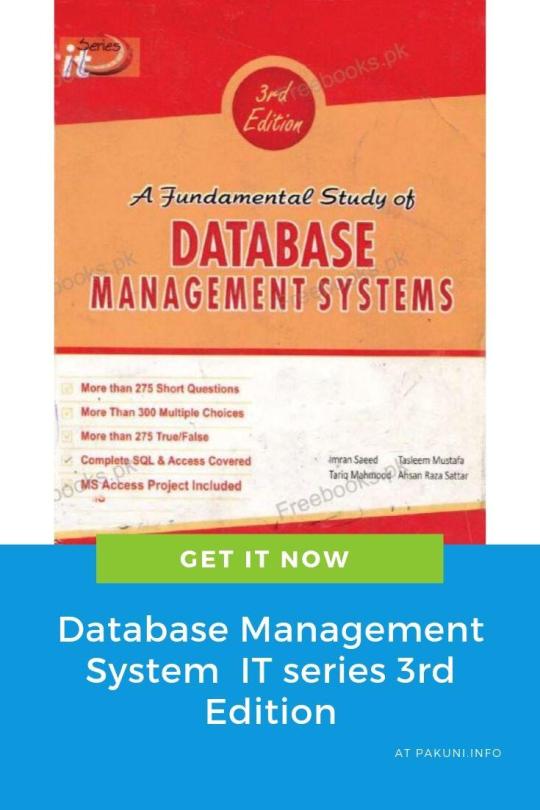
DOWNLOAD DBMS pdf book free
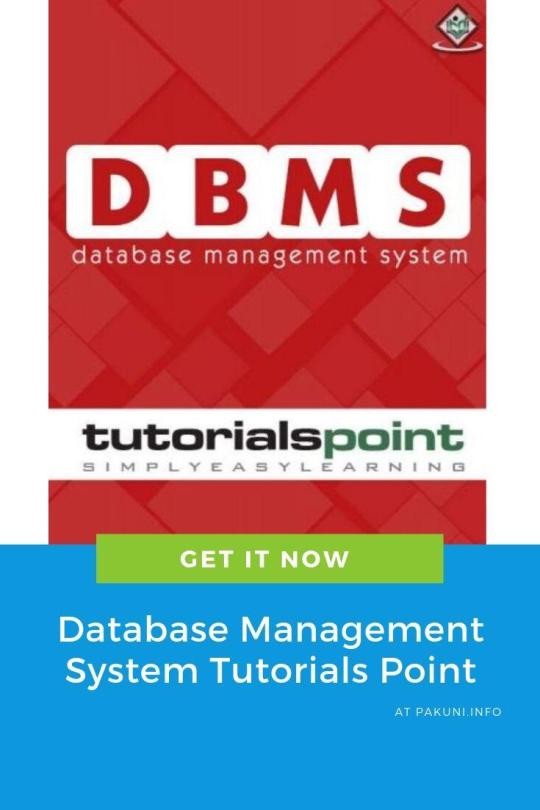
DOWNLOAD fundamentals of DBMS
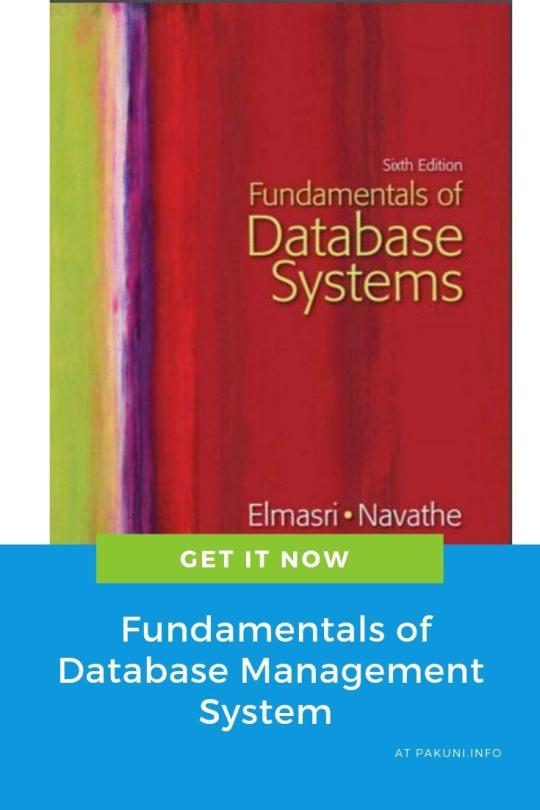
DOWNLOAD
Database management system Video Tutorials
DBMS Complete tutorial for beginners Introduction to database management system (Complete) Best DBMS complete tutorial(urdu/hindi)
Get Access to Paid Introduction to DBMS Courses and Books exclusive on Amazon, Khan Academy, Scribd, Coursea, Bightthink, EDX and BrightStorm
Check out on Amazon Store Check out on Khan Academy Check out on COURSEA Check out on Bright Storm Check out on Edx.com Read and Learn More about on BIGTHINK Get more Details about Bachelor's Degree Courses Here. These Course contents belong to HEC outline for this specific Subject. If you have any further inquiries, Please Contact US for details via mail. All the data is extracted from HEC official website. The basic purpose for this to find all course subjects data on one page. Read the full article
#bachelorofscienceinsoftwareengineering#BSCSBooks#BSITBooks#BSsoftwareEngineering#databasemanagementsystem#databasemanagementsystemcourse#databasemanagementsystempdfnotes#databasemanagementsystemtutorial
0 notes
Text
Research On World Data Base Management Systems (DBMS) Market Report 2025
Report on World Data Base Management Systems (DBMS) Market by Product Type, Market, Players and Regions-Forecast to 2025 offered by DecisionDatabases.com.
Data Base Management Systems (DBMS) market research report provides the newest industry data and industry future trends, allowing you to identify the products and end users driving Revenue growth and profitability.
The industry report lists the leading competitors and provides the insights strategic industry Analysis of the key factors influencing the market.
The report includes the forecasts, Analysis and discussion of important industry trends, market size, market share estimates and profiles of the leading industry Players.
Final Report will cover the impact of COVID-19 on this industry.
Browse the complete report and table of contents @ https://www.decisiondatabases.com/ip/33455-data-base-management-systems-dbms-market-analysis-report
The Players mentioned in our report
Oracle
IBM
Microsoft
PostgreSQL
Sybase
Global Data Base Management Systems (DBMS) Market: Product Segment Analysis
Relational database management system (RDMS)
In-memory database management system (IMDBMS)
Columnar database management system (CDBMS)
Global Data Base Management Systems (DBMS) Market: Application Segment Analysis
Global Data Base Management Systems (DBMS) Market: Regional Segment Analysis
USA
Europe
Japan
China
India
South East Asia
Download Free Sample Report of World Data Base Management Systems (DBMS) Market @ https://www.decisiondatabases.com/contact/download-sample-33455
There are 10 Chapters to Deeply Display the World Data Base Management Systems (DBMS) Market. Chapter 1 About the Data Base Management Systems (DBMS) Industry Chapter 2 World Market Competition Landscape Chapter 3 World Data Base Management Systems (DBMS) Market share Chapter 4 Supply Chain Analysis Chapter 5 Company Profiles Chapter 6 Globalisation & Trade Chapter 7 Distributors and Customers Chapter 8 Import, Export, Consumption and Consumption Value by Major Countries Chapter 9 World Data Base Management Systems (DBMS) Market Forecast through 2025 Chapter 10 Key success factors and Market Overview
Purchase the complete World Data Base Management Systems (DBMS) Market Research Report @ https://www.decisiondatabases.com/contact/buy-now-33455
Other Reports by DecisionDatabases.com:
World Marketing Account Management Software Market Research Report Forecast 2025
World Tax Management Software Market Research Report 2025 (Covering USA, Europe, China, Japan, India and etc)
World Facility Management (FM) Services Market Research Report 2025 (Covering USA, Europe, China, Japan, India and etc)
About-Us: DecisionDatabases.com is a global business research reports provider, enriching decision makers and strategists with qualitative statistics. DecisionDatabases.com is proficient in providing syndicated research report, customized research reports, company profiles and industry databases across multiple domains.
Our expert research analysts have been trained to map client’s research requirements to the correct research resource leading to a distinctive edge over its competitors. We provide intellectual, precise and meaningful data at a lightning speed.
For more details: DecisionDatabases.com E-Mail: [email protected] Phone: +91 9028057900 Web: https://www.decisiondatabases.com/
#Data Base Management Systems#Data Base Management Systems (DBMS) Market#Data Base Management Systems (DBMS) Market Report#World Data Base Management Systems (DBMS) Market#Data Base Management Systems (DBMS) Industry SIze
0 notes
Text
The Technology Email List
Hello Everyone I would like to be explaining best portal to buy a Technology Email List
Let me explain ..
The Technology Email List from #GermanyMailingList LLC ensures successful marketing result using the records from the fresh, upgraded database. Our #TechnologyEmailusers Database Customers Mailing Addresses is the most systematic way for channelizing campaigns and expanding client base across markets systematically.
Germany Mailing List provides a comprehensive technology user list to clients. We have made it easier for you to reach out to your potential clientele only with a click. Our technology users email list has been compiled after a lot of research and hence is accurate and reliable.
We are leading technology email list seller dedicated to managing both email and mailing database related to technology industry. Our technology lists include #ASP users, CRM users, SAP industry, #ERP industry, JD Edwards executives, Lawson Application users, Oracle application users and other technology industry users.
We make an effort to keep it updated so our clients have an edge over the others. With the help of our updated technology user list you can acquire and retain the best customers.
We custom build the lists based on the marketing campaign and various target demographics to help our clients expand reach to a more specific target audience who are most likely to buy their product or service.
Over the years, we have earned the most valued trust and respect from hundreds of our clients who have expressed their utter satisfaction after availing our products & services. Through our wide range of solutions we proudly claim to deliver some of the best quality services worldwide.
Reaching out to the functional heads can help you collaborate with them and achieve your business goals. We have clients seeking our mailing services from various industrial sectors like telecommunications, retail, defence, aerospace, energy, government, education, engineering, finance, healthcare, construction, logistics and manufacturing.Reaching Technology Users is now easy. #GermanyMailingList Contacts offers TechnologyEmailDatabase. We offer targeted technology list, which helps you to market your product or services. Our highly responsive Technology Email Database will help you reach your target audience from small business to fortune companies.
Our Technology List:
#AppleUsersMailinglists
#Asp users email lists
#Baan users email lists
#Cisco Network Users Mailing lists
#CRM Users Mailing lists
.#Net application users email lists
#ERP users email lists
#IBM DBMS users email lists
#In for applications user email list
#InfusionSoft Users Mailing lists
The Job titles include
Sales Titles, IT titles, CEO/President, CFO, CIO, VP, COO etc., HR titles, Finance titles, Operation titles, Marketing titles
Advantage using Germany Mailing List Technology Users Mailing List
Latest email IDs of executives
Provides sales volume and contact information
Helps in brand building and enhancing sales
Why Get Technology Lists?
Accurate and contain crucial contact details of technical professionals
Verified by in-house data experts with respective technical professionals
Updated to include changes in job, industry, profile, etc.
Placed into specific sub-categories
For more Details Visit:
http://www.germanymailinglist.com/technology/IBM-iSeries-Users-Email-List.html
0 notes
Link
Leverage a highly-targeted and authentic Oracle DBMS users list to get your message conveyed to the right audience located across the globe.
0 notes
Text
2019's Best Database Management system PDF Notes, Books Course Data and Tutorials
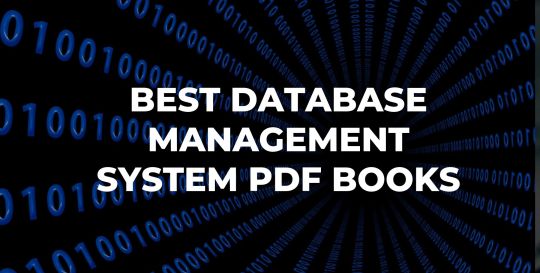
Introduction to a database management system
A database is an organized collection of data, generally stored and accessed electronically from a computer system. Where databases are more complex they are often developed using formal design and modeling techniques. The database management system (DBMS) is the software that interacts with end users, applications, and the database itself to capture and analyze the data. The DBMS software additionally encompasses the core facilities provided to administer the database. The sum total of the database, the DBMS and the associated applications can be referred to as a "database system". Often the term "database" is also used to loosely refer to any of the DBMS, the database system or an application associated with the database. Computer scientists may classify database-management systems according to the database models that they support. Relational databases became dominant in the 1980s. These model data as rows and columns in a series of tables, and the vast majority use SQL for writing and querying data. In the 2000s, non-relational databases became popular, referred to as NoSQL because they use different query languages. Formally, a "database" refers to a set of related data and the way it is organized. Access to this data is usually provided by a "database management system" (DBMS) consisting of an integrated set of computer software that allows users to interact with one or more databases and provides access to all of the data contained in the database (although restrictions may exist that limit access to particular data). The DBMS provides various functions that allow entry, storage and retrieval of large quantities of information and provides ways to manage how that information is organized. Because of the close relationship between them, the term "database" is often used casually to refer to both a database and the DBMS used to manipulate it. Both a database and its DBMS conform to the principles of a particular database model. "Database system" refers collectively to the database model, database management system, and database.
History of database management system
The sizes, capabilities, and performance of databases and their respective DBMSs have grown in orders of magnitude. These performance increases were enabled by the technology progress in the areas of processors, computer memory, computer storage, and computer networks. The development of database technology can be divided into three eras based on data model or structure: navigational, SQL/relational, and post-relational. The two main early navigational data models were the hierarchical model and the CODASYL model (network model) The relational model, first proposed in 1970 by Edgar F. Codd, departed from this tradition by insisting that applications should search for data by content, rather than by following links. The relational model employs sets of ledger-style tables, each used for a different type of entity. Only in the mid-1980s did computing hardware become powerful enough to allow the wide deployment of relational systems (DBMSs plus applications). By the early 1990s, however, relational systems dominated in all large-scale data processing applications, and as of 2018 they remain dominant: IBM DB2, Oracle, MySQL, and Microsoft SQL Server are the most searched DBMS. The dominant database language, standardised SQL for the relational model, has influenced database languages for other data models. Object databases were developed in the 1980s to overcome the inconvenience of object-relational impedance mismatch, which led to the coining of the term "post-relational" and also the development of hybrid object-relational databases. The next generation of post-relational databases in the late 2000s became known as NoSQL databases, introducing fast key-value stores and document-oriented databases. A competing "next generation" known as NewSQL databases attempted new implementations that retained the relational/SQL model while aiming to match the high performance of NoSQL compared to commercially available relational DBMSs.
This Outline Will be similar with your University Course Outline for Database Management System.
Basic database concepts, database architecture, DB design life cycle, schema architecture, Conceptual, Logical and Physical database modeling and design, Mapping ERD to relational model, Functional Dependencies and Normalization, Relational Algebra , Structured Query Language (SQL), Transaction Processing, Concurrencsy Control and Recovery Techniques, Query Optimization Concepts._
Best Recommended Fundamentals of Database Management System PDF Notes and Books in Universities:
Here is detailed list of best Fundamentals of Database Management System books for Universities: database management system A Practical Approach to Design, Implementation and Management, Thomas Connolly and Carolyn Begg, Prentice Hall. Modern database management system by Fred McFadden, Jeffrey Hoofer , Mary Prescott, Prentice Hall
Free Database Management System PDF Notes and Books and Helping Material to Download
Database Management System IT series 3rd Edition
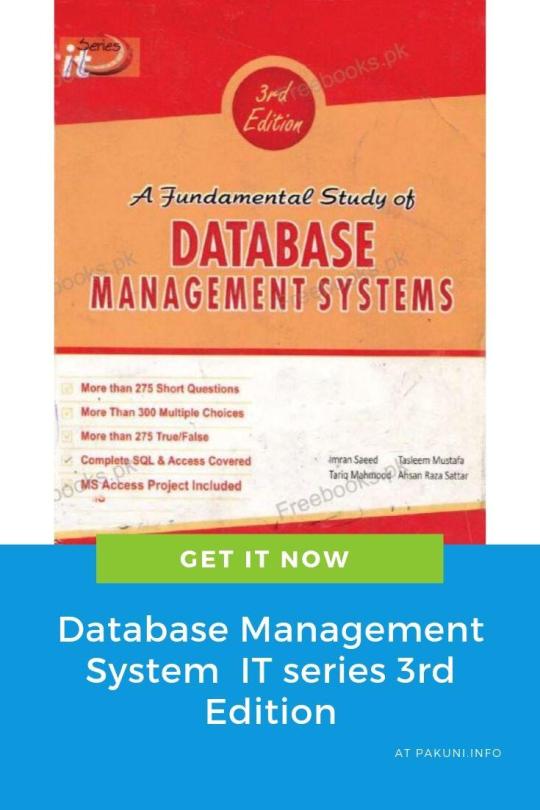
DOWNLOAD DBMS pdf book free
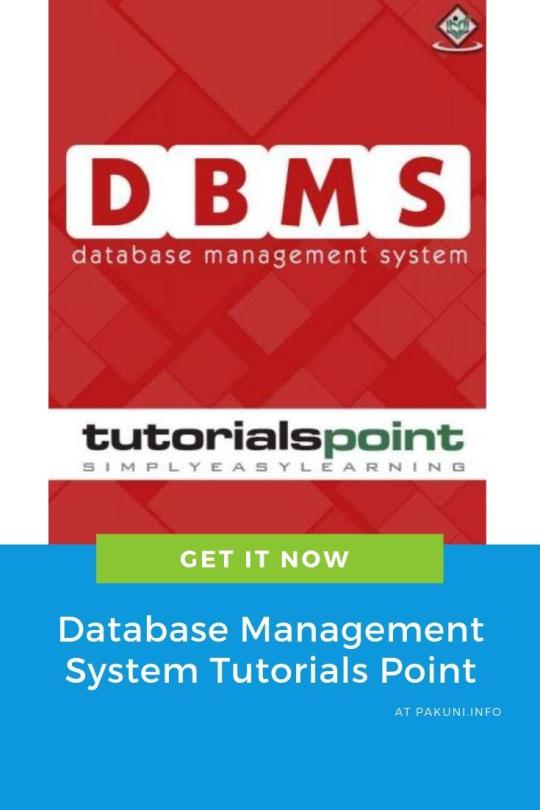
DOWNLOAD fundamentals of DBMS
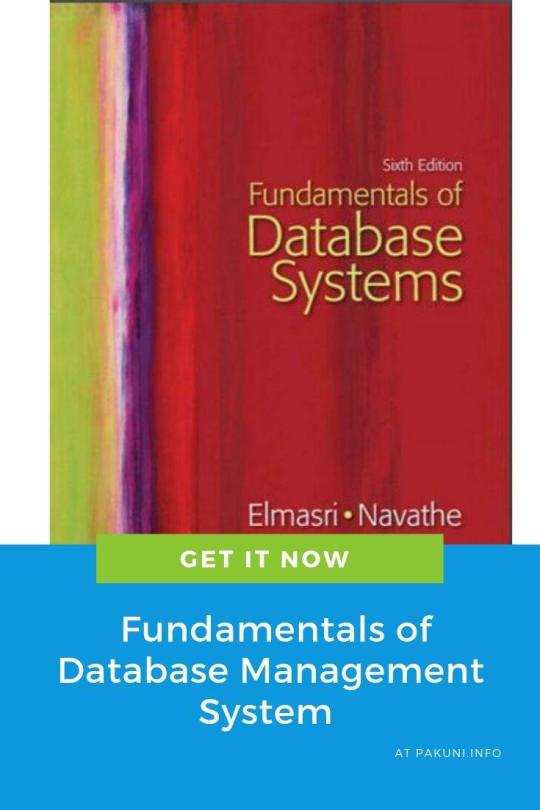
DOWNLOAD
Database management system Video Tutorials
DBMS Complete tutorial for beginners Introduction to database management system (Complete) Best DBMS complete tutorial(urdu/hindi)
Get Access to Paid Introduction to DBMS Courses and Books exclusive on Amazon, Khan Academy, Scribd, Coursea, Bightthink, EDX and BrightStorm
Check out on Amazon Store Check out on Khan Academy Check out on COURSEA Check out on Bright Storm Check out on Edx.com Read and Learn More about on BIGTHINK Get more Details about Bachelor's Degree Courses Here. These Course contents belong to HEC outline for this specific Subject. If you have any further inquiries, Please Contact US for details via mail. All the data is extracted from HEC official website. The basic purpose for this to find all course subjects data on one page. Read the full article
0 notes
Text
best database management system PDF Notes, Books Course Data and Tutorials 2019
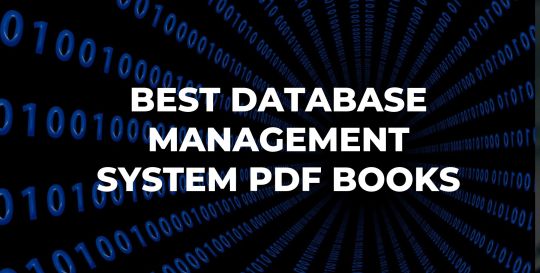
A database is an organized collection of data, generally stored and accessed electronically from a computer system. Where databases are more complex they are often developed using formal design and modeling techniques. The database management system (DBMS) is the software that interacts with end users, applications, and the database itself to capture and analyze the data. The DBMS software additionally encompasses the core facilities provided to administer the database. The sum total of the database, the DBMS and the associated applications can be referred to as a "database system". Often the term "database" is also used to loosely refer to any of the DBMS, the database system or an application associated with the database. Computer scientists may classify database-management systems according to the database models that they support. Relational databases became dominant in the 1980s. These model data as rows and columns in a series of tables, and the vast majority use SQL for writing and querying data. In the 2000s, non-relational databases became popular, referred to as NoSQL because they use different query languages. Formally, a "database" refers to a set of related data and the way it is organized. Access to this data is usually provided by a "database management system" (DBMS) consisting of an integrated set of computer software that allows users to interact with one or more databases and provides access to all of the data contained in the database (although restrictions may exist that limit access to particular data). The DBMS provides various functions that allow entry, storage and retrieval of large quantities of information and provides ways to manage how that information is organized. Because of the close relationship between them, the term "database" is often used casually to refer to both a database and the DBMS used to manipulate it. Both a database and its DBMS conform to the principles of a particular database model. "Database system" refers collectively to the database model, database management system, and database.The sizes, capabilities, and performance of databases and their respective DBMSs have grown in orders of magnitude. These performance increases were enabled by the technology progress in the areas of processors, computer memory, computer storage, and computer networks. The development of database technology can be divided into three eras based on data model or structure: navigational, SQL/relational, and post-relational. The two main early navigational data models were the hierarchical model and the CODASYL model (network model) The relational model, first proposed in 1970 by Edgar F. Codd, departed from this tradition by insisting that applications should search for data by content, rather than by following links. The relational model employs sets of ledger-style tables, each used for a different type of entity. Only in the mid-1980s did computing hardware become powerful enough to allow the wide deployment of relational systems (DBMSs plus applications). By the early 1990s, however, relational systems dominated in all large-scale data processing applications, and as of 2018 they remain dominant: IBM DB2, Oracle, MySQL, and Microsoft SQL Server are the most searched DBMS. The dominant database language, standardised SQL for the relational model, has influenced database languages for other data models. Object databases were developed in the 1980s to overcome the inconvenience of object-relational impedance mismatch, which led to the coining of the term "post-relational" and also the development of hybrid object-relational databases. The next generation of post-relational databases in the late 2000s became known as NoSQL databases, introducing fast key-value stores and document-oriented databases. A competing "next generation" known as NewSQL databases attempted new implementations that retained the relational/SQL model while aiming to match the high performance of NoSQL compared to commercially available relational DBMSs.
This Outline Will be similar with your University Course Outline for Database Management System.
Basic database concepts, database architecture, DB design life cycle, schema architecture, Conceptual, Logical and Physical database modeling and design, Mapping ERD to relational model, Functional Dependencies and Normalization, Relational Algebra , Structured Query Language (SQL), Transaction Processing, Concurrencsy Control and Recovery Techniques, Query Optimization Concepts._
Best Recommended Fundamentals of Database Management System PDF Notes and Books in Universities:
Here is detailed list of best Fundamentals of Database Management System books for Universities: database management system A Practical Approach to Design, Implementation and Management, Thomas Connolly and Carolyn Begg, Prentice Hall. Modern database management system by Fred McFadden, Jeffrey Hoofer , Mary Prescott, Prentice Hall Database Management System IT series 3rd Edition DBMS pdf book free fundamentals of DBMS DBMS Complete tutorial for beginners Introduction to database management system (Complete) Best DBMS complete tutorial(urdu/hindi)
Get Access to Paid Introduction to Economics Courses and Books exclusive on Amazon, Khan Academy, Scribd, Coursea, Bightthink, EDX and BrightStorm
Check out on Amazon Store Check out on Khan Academy Check out on COURSEA Check out on Bright Storm Check out on Edx.com Read and Learn More about on BIGTHINK Get more Details about Bachelor's Degree Courses Here. These Course contents belong to HEC outline for this specific Subject. If you have any further inquiries, Please Contact US for details via mail. All the data is extracted from HEC official website. The basic purpose for this to find all course subjects data on one page. Read the full article
0 notes
Text
Technology Users Mailing List
Buy Prepackaged & Customized Technology Users List, Technology Decision Makers List and Technology Users Mailing List By SIC Code That Let You Reach Targeted Markets In The USA, UK, Canada, Europe & Australia!
Today’s technology industry is a mainstay of most developed economies and remains unsurpassed in terms of industry evolution and dynamics. With the advent of third-party software solution providers, major software and database management systems are rapidly becoming highly customized to suit needs ranging from general ERP to specific project-linked goals. Global Reuters provide best technology email lists to clients and customers. As they stand today, software applications have a massive market by way of enterprises that utilize any kind of data management software. And, with lists comprising technology vendors, technology users and technology executives, we’re here to help you capture that market!
Global Reuters prides itself on being able to deliver absolutely accurate lists of specific software users in virtually any field of operations. Our databases contain thousands of Technology Users List, Java, .Net, Oracle and SAP User Companies, besides myriad other DBMS users lists, located throughout North America and Europe.
And we, at Global Reuters, make sure you can effectively tap into that market.
Global Reuters Technology Users List includes:
Sage ACT CRM Users List
SugarCRM Users List
IBM Mainframe Users List
Amdocs CRM Users List
Avaya Users Mailing List
Big Data Users Mailing List
Cisco Network Users Mailing List
NetSuite Users Mailing List
GoldMine CRM Users Mailing List
Salesforce CRM Users Mailing List
Oracle Users Mailing List
Unix Users Mailing List
ERP Users Mailing List
SAP Users Mailing List
JD Edwards Users Mailing List
IT Executives Mailing List
Linux Users Mailing List
Microsoft Users Mailing List
Lawson Applications Users List
Java Users Mailing List
Oracle Database Users List
Siebel CRM Users Mailing List
AS400 & iSeries Users Mailing List
Lawson Software Users List
PeopleSoft Users Mailing List
.Net Users Mailing List
Sybase DBMS Users Mailing List
Adobe Users Mailing List
ASP.NET Users Mailing List
BAAN Users Mailing List
Infor Applications User List
Microsoft Dynamics GP Users List
3COM Users Mailing List
Software Developers Mailing List
IBM DBMS Users Lists
Arial Software users list
Altova Users Mailing List
Air2Web Users Mailing List
ACE Project Users Mailing List
aiSee Users Mailing List
Accellion Users Mailing List
Actuate Users Mailing List
Adobe CQ5(CMS) Users
Acronis True Image Software
Accounting Software Users
AirWatch (MDM) Customers
Akamai Users Mailing Database
Altair Users List
Altium Customers Mailing List
Amazon Web Services Customers
Amazon RDS Users
Amisys Software Customers
Apache Mesos Vendors List
Apache Spark Clients’ Database
APM Software Users List
Archibus Users Mailing Database
Arkeia Smart Backup User
Aruba Networks Users
Atlassian Users List
Axway Users List
Eloqua Users List
3D Animation Software Users
Alpha Anywhere Software Users
Marketo Users List
QuickBooks Users List
Cloud Computing Users List
All Technology Users Email List provide complete marketing information including;
First Name, Last Name
Contact Title
Phone Number, Fax Number
Email, Postal Address, and Zip Code.
Company Name
Web Address
SIC Code & NAICS Code
0 notes
Text
Database Management System PDF Notes, Books Course Data and Tutorials
Info is an associate organized assortment of data, typically keep and accessed electronically from a computer system. wherever databases ar additional advanced they’re typically developed exploitation formal style and modeling techniques. The management system (DBMS) is the code that interacts with finish users, applications, and also the data itself to capture and analyze the knowledge. The software code, additionally , encompasses the core facilities provided to administer the data . The summation of the data , the software and also the associated applications is mentioned as a “database system”. typically the term “database” is additionally accustomed loosely ask any of the software systems, the data system or associate application associated with the data . Computer scientists might classify info-management systems keep with the database models that they support. relative databases became dominant within the 19 Eighties. These model information as rows and columns during a series of tables, and also the overwhelming majority use SQL for writing and querying information. within the 2000s, non-relational databases became widespread, mentioned as NoSQL as a results of they use totally different question languages. Formally, a “database” refers to a gaggle of connected information and also the tactic it’s organized. Access to this information is usually provided by a “database management system” (DBMS) consisting of associate integrated set of pc code that permits users to maneuver with one or additional information and provides access to all or any or any or any or any of the knowledge contained within the database (although restrictions might exist that limit access to explicit data). Because of the shut relationship between them, the term “database” is usually used nonchalantly to ask each an info and also the software familiar with manipulate it. Both a info and its software adapt to the principles of a specific info model.
History of database management system
The sizes, capabilities, and performance of databases and their several DBMSs have adult in orders of magnitude. This performance will increase were enabled by the technology progress within the fields of processors, memory devices, memory devices, and pc networks. the event of knowledge technology is split into 3 eras supported information model or structure: direction, SQL/relational, and post-relational. The two main early direction information models were the gradable model and also the CODASYL model (network model) The relative model, 1st planned in 1970 by Edgar F. Codd, departed from this tradition by the appliance that applications need to search for information by content, rather of by following links. The relative model employs sets of ledger-style tables, every used for a special quite entity. solely within the mid-1980s did computing hardware become powerful enough to allow the wide readying of relative systems (DBMSs and applications). By the primary Nineteen Nineties, but, relative systems dominated collectively large-scale processing applications, and as of 2018 they proceed to be dominant: IBM DB2, Oracle, MySQL, and Microsoft SQL The dominant info language, standardized SQL for the relative model, has influenced info languages for various information models Object databases were developed within the 19 Eighties to beat the inconvenience of object-relational electric resistance pair, that diode to the coining of the term “post-relational” and additionally the The next generation of post-relational databases within the late 2000s became named NoSQL databases, introducing quick key-value stores and document-oriented databases.
This Outline Will be similar with your University Course Outline for Database Management System.
Basic database concepts, DB design life cycle, schema architecture, database architecture, Conceptual, L Mapping ERD to relational model, ogical and Physical database modeling and design, Functional Dependencies and Normalization, Relational Algebra, Functional Dependencies and Normalization, Structured Query Language (SQL), Transaction Processing, Concurrencsy Control and Recovery Techniques, Query Optimization Concepts._
Best Recommended Fundamentals of Database Management System PDF Notes and Books in Universities:
Here is detailed list of best Fundamentals of Database Management System books for Universities: database management system A Practical Approach to Design, Implementation and Management by Thomas Connolly and Carolyn Begg Modern database management system by Fred McFadden, Jeffrey Hoofer , Mary Prescott Database Management System IT series 3rd Edition DBMS pdf book free fundamentals of DBMS DBMS Complete tutorial for beginners Introduction to database management system (Complete) Best DBMS complete tutorial(urdu/hindi)
Get Access to Paid Introduction to DBMS Courses and Books exclusive on Amazon, Khan Academy, Scribd, Coursea, Bightthink, EDX and BrightStorm
Check out on Amazon Store Check out on Khan Academy Check out on COURSEA Check out on Bright Storm Check out on Edx.com Read and Learn More about on BIGTHINK Get more Details about Bachelor's Degree Courses Here. These Course contents belong to HEC outline for this specific Subject. If you have any further inquiries, Please Contact US for details via mail. All the data is extracted from HEC official website. The basic purpose for this to find all course subjects data on one page. Read the full article
#bachelorofscienceinsoftwareengineering#BSCSBooks#BSITBooks#BSsoftwareEngineering#databasemanagementsystem#databasemanagementsystemcourse#databasemanagementsystempdfnotes#databasemanagementsystemtutorial
0 notes
Text
2019's Best Database Management System PDF Notes, Books Course Data and Tutorials
A database is an organized collection of data, generally stored and accessed electronically from a computer system. Where databases are more complex they are often developed using formal design and modeling techniques. The database management system (DBMS) is the software that interacts with end users, applications, and the database itself to capture and analyze the data. The DBMS software additionally encompasses the core facilities provided to administer the database. The sum total of the database, the DBMS and the associated applications can be referred to as a "database system". Often the term "database" is also used to loosely refer to any of the DBMS, the database system or an application associated with the database. Computer scientists may classify database-management systems according to the database models that they support. Relational databases became dominant in the 1980s. These model data as rows and columns in a series of tables, and the vast majority use SQL for writing and querying data. In the 2000s, non-relational databases became popular, referred to as NoSQL because they use different query languages. Formally, a "database" refers to a set of related data and the way it is organized. Access to this data is usually provided by a "database management system" (DBMS) consisting of an integrated set of computer software that allows users to interact with one or more databases and provides access to all of the data contained in the database (although restrictions may exist that limit access to particular data). The DBMS provides various functions that allow entry, storage and retrieval of large quantities of information and provides ways to manage how that information is organized. Because of the close relationship between them, the term "database" is often used casually to refer to both a database and the DBMS used to manipulate it. Both a database and its DBMS conform to the principles of a particular database model. "Database system" refers collectively to the database model, database management system, and database.The sizes, capabilities, and performance of databases and their respective DBMSs have grown in orders of magnitude. These performance increases were enabled by the technology progress in the areas of processors, computer memory, computer storage, and computer networks. The development of database technology can be divided into three eras based on data model or structure: navigational, SQL/relational, and post-relational. The two main early navigational data models were the hierarchical model and the CODASYL model (network model) The relational model, first proposed in 1970 by Edgar F. Codd, departed from this tradition by insisting that applications should search for data by content, rather than by following links. The relational model employs sets of ledger-style tables, each used for a different type of entity. Only in the mid-1980s did computing hardware become powerful enough to allow the wide deployment of relational systems (DBMSs plus applications). By the early 1990s, however, relational systems dominated in all large-scale data processing applications, and as of 2018 they remain dominant: IBM DB2, Oracle, MySQL, and Microsoft SQL Server are the most searched DBMS. The dominant database language, standardised SQL for the relational model, has influenced database languages for other data models. Object databases were developed in the 1980s to overcome the inconvenience of object-relational impedance mismatch, which led to the coining of the term "post-relational" and also the development of hybrid object-relational databases. The next generation of post-relational databases in the late 2000s became known as NoSQL databases, introducing fast key-value stores and document-oriented databases. A competing "next generation" known as NewSQL databases attempted new implementations that retained the relational/SQL model while aiming to match the high performance of NoSQL compared to commercially available relational DBMSs.
This Outline Will be similar with your University Course Outline for Database Management System.
Basic database concepts, database architecture, DB design life cycle, schema architecture, Conceptual, Logical and Physical database modeling and design, Mapping ERD to relational model, Functional Dependencies and Normalization, Relational Algebra , Structured Query Language (SQL), Transaction Processing, Concurrencsy Control and Recovery Techniques, Query Optimization Concepts._
Best Recommended Fundamentals of Database Management System PDF Notes and Books in Universities:
Here is detailed list of best Fundamentals of Database Management System books for Universities: database management system A Practical Approach to Design, Implementation and Management, Thomas Connolly and Carolyn Begg, Prentice Hall. Modern database management system by Fred McFadden, Jeffrey Hoofer , Mary Prescott, Prentice Hall Database Management System IT series 3rd Edition DBMS pdf book free fundamentals of DBMS DBMS Complete tutorial for beginners Introduction to database management system (Complete) Best DBMS complete tutorial(urdu/hindi)
Get Access to Paid Introduction to DBMS Courses and Books exclusive on Amazon, Khan Academy, Scribd, Coursea, Bightthink, EDX and BrightStorm
Check out on Amazon Store Check out on Khan Academy Check out on COURSEA Check out on Bright Storm Check out on Edx.com Read and Learn More about on BIGTHINK Get more Details about Bachelor's Degree Courses Here. These Course contents belong to HEC outline for this specific Subject. If you have any further inquiries, Please Contact US for details via mail. All the data is extracted from HEC official website. The basic purpose for this to find all course subjects data on one page. Read the full article
#bachelorofscienceinsoftwareengineering#BSCSBooks#BSITBooks#BSsoftwareEngineering#databasemanagementsystem#databasemanagementsystemcourse#databasemanagementsystempdfnotes#databasemanagementsystemtutorial
0 notes